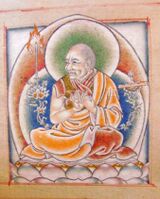'gos lo tsA ba gzhon nu dpal: Difference between revisions
No edit summary |
No edit summary |
||
| Line 25: | Line 25: | ||
|BdrcLink=https://www.tbrc.org/#!rid=P318 | |BdrcLink=https://www.tbrc.org/#!rid=P318 | ||
|TolLink=https://treasuryoflives.org/biographies/view/Go-Lotsawa-Zhonnu-Pel/5500 | |TolLink=https://treasuryoflives.org/biographies/view/Go-Lotsawa-Zhonnu-Pel/5500 | ||
|tolExcerpt=Go Lotsāwa | |tolExcerpt=Go Lotsāwa Zhonnu Pel was the author of the important Tibetan history ''The Blue Annals''. A Kagyu polymath, he studied under some sixty prominent lamas, chief among them the Fifth Karmapa Dezhin Shekpa. He was a Sanskrit scholar and served as translator to an Indian scholar Paṇḍit Vanaratna for five years. He was a teacher of the Seventh Karmapa, Chodrak Gyatso, and the Fourth Zhamar, Chodrak Yeshe. | ||
|HarLink=https://www.himalayanart.org/search/set.cfm?setID=976 | |HarLink=https://www.himalayanart.org/search/set.cfm?setID=976 | ||
|PosBuNayDefProv=Definitive | |PosBuNayDefProv=Definitive | ||
Latest revision as of 20:34, 3 August 2020
| PersonType | Category:Classical Tibetan Authors |
|---|---|
| MainNamePhon | Gö Lotsāwa Zhönu Pal |
| MainNameTib | འགོས་ལོ་ཙཱ་བ་གཞོན་ནུ་དཔལ་ |
| MainNameWylie | 'gos lo tsA ba gzhon nu dpal |
| SortName | Gö Lotsāwa |
| AltNamesTib | ཡིད་བཟང་རྩེ་བ་ · མགོས་ལོ་ཙཱ་བ་གཞོན་ནུ་དཔལ་ |
| AltNamesWylie | yid bzang rtse ba · mgos lo tsA ba gzhon nu dpal · 'gos lo tsā ba gzhon nu dpal |
| YearBirth | 1392 |
| YearDeath | 1481 |
| BornIn | grong nag me dgu ('phyongs rgyas) |
| TibDateGender | Male |
| TibDateElement | Water |
| TibDateAnimal | Monkey |
| TibDateRabjung | 7 |
| ReligiousAffiliation | Karma Kagyu |
| StudentOf | Third Shamarpa Chopel Yeshe · Fifth Karmapa Deshin Shekpa · Tsongkhapa · Rongtön Sheja Kunrik |
| TeacherOf | Fourth Shamarpa Chodrak Yeshe · Seventh Karmapa Chödrak Gyatso |
| BDRC | https://www.tbrc.org/#!rid=P318 |
| Treasury of Lives | https://treasuryoflives.org/biographies/view/Go-Lotsawa-Zhonnu-Pel/5500 |
| Himalayan Art Resources | https://www.himalayanart.org/search/set.cfm?setID=976 |
| IsInGyatsa | No |
| PosBuNayDefProv | Definitive |
| PosBuNayDefProvNotes |
|
| PosWheelTurn | Third Turning |
| PosYogaMadhya | Yogācāra |
| PosYogaMadhyaNotes | Though his own view is based on Mahāmudrā, for which he asserts RGV is an important basis. |
| PosAnalyticMedit | Meditative Tradition |
| PosAnalyticMeditNotes | "That Zhönu Pal comments on the Ratnagotravibhāga from within the tradition of meditation is also clear from his colophon:
The Dharma master Drigungpa [Jigten Sumgön] rejoiced in Jé Gampopas statement that the basic text of these mahāmudrā instructions of ours is the [Ratnagotravibhāga] Mahāyānottaratantraśāstra composed by the illustrious Maitreya; and since it is evident that the notes to [his] Uttaratantra explanations, the points he makes when presenting the three dharmacakras, and also the explanations deriving from Sajjana’s heart disciple Tsen Kawoché, are [all] in accordance with mahāmudrā proper, I have relied on them and have made [this] clear to others as best as I could. (DRSM, 574.9-12)" Klaus-Dieter Mathes, A Direct Path to the Buddha Within, p. 368. |
| PosEmptyLumin | Tathāgatagarbha as Mind's Luminous Nature |
| PosEmptyLuminNotes |
|
| Other wikis |
If the page does not yet exist on the remote wiki, you can paste the tag |

